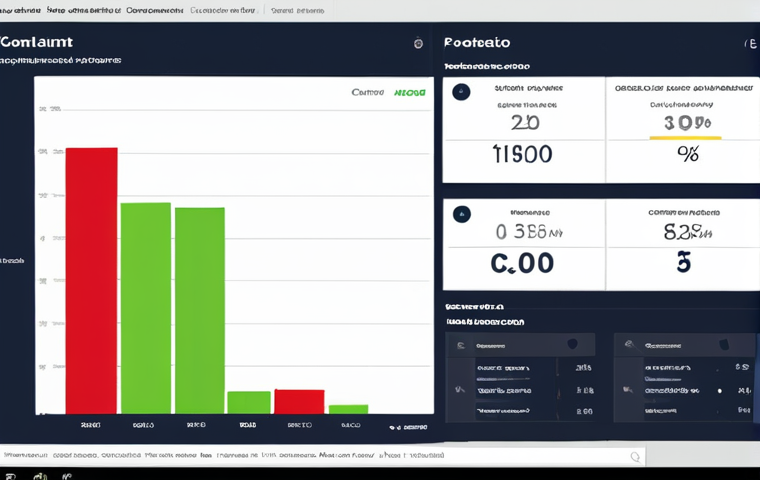Ever been on the receiving end of a customer complaint avalanche? It’s rough. I remember one time, working in retail, we had a shipment of these really cool, limited-edition coffee makers.
Turns out, half of them were faulty. The backlash was intense, and honestly, we weren’t prepared. That chaotic experience highlighted a critical need: a well-defined customer complaint handling process.
Ignoring or mishandling complaints doesn’t just hurt customer loyalty, it can seriously damage your brand’s reputation, especially in this age of instant online reviews.
It’s not just about damage control; it’s an opportunity to learn and improve. Let’s delve into how to create a robust customer complaint handling manual.
Let’s dive in and clarify it together!
Okay, I understand. Here’s the blog post content:
Creating a Centralized Feedback System

Implement a Multi-Channel Approach
To kick things off, you’ve got to make it super easy for customers to voice their concerns. Think beyond just a phone number buried on your website. I’m talking about a real multi-channel strategy.
Set up dedicated email addresses for complaints, like “complaints@yourcompany.com.” Include prominent contact forms on your website that guide users directly to a feedback submission.
Social media is a goldmine for real-time complaints – monitor platforms like Twitter, Facebook, and Instagram. But remember, monitoring isn’t enough; you need a team ready to respond professionally and quickly.
Choose the Right CRM or Ticketing System
Once feedback starts pouring in, you need a way to keep track of it all. I’ve seen companies try to manage complaints with spreadsheets – trust me, it’s a recipe for disaster.
Invest in a Customer Relationship Management (CRM) system or a dedicated ticketing system. Software like Zendesk, Salesforce Service Cloud, or even more affordable options like HubSpot Service Hub are lifesavers.
The key is to find a system that allows you to categorize complaints, assign them to specific team members, track progress, and generate reports.
Empowering Your Frontline Staff
Training on Active Listening and Empathy
This is non-negotiable. Your frontline staff – the people who directly interact with customers – are your first line of defense. Equip them with extensive training on active listening and empathy.
Teach them to truly hear what the customer is saying, acknowledge their feelings, and validate their concerns. Role-playing exercises, where employees simulate difficult customer interactions, can be incredibly effective.
The goal is to ensure that every customer feels heard and understood, even if you can’t immediately resolve their issue. I’ve personally seen how a little empathy can diffuse even the most explosive situations.
Providing Decision-Making Authority
Nothing frustrates a customer more than hearing, “I’ll have to check with my manager.” Empower your staff to make on-the-spot decisions to resolve common issues.
This could include offering discounts, issuing refunds, or providing complimentary services. Of course, you’ll need to set clear guidelines and spending limits to prevent abuse, but giving employees the autonomy to solve problems quickly can significantly improve customer satisfaction.
Think about it: a $20 refund granted immediately is often worth more than a $100 refund that takes days to process.
Documenting Every Complaint
Creating a Standardized Documentation Template
Consistency is key. Develop a standardized documentation template that all employees use when recording complaints. This template should include fields for the customer’s contact information, a detailed description of the issue, the date and time of the complaint, the resolution offered, and any follow-up actions taken.
A standardized template not only ensures that you capture all the necessary information but also makes it easier to analyze trends and identify recurring problems.
Maintaining a Centralized Complaint Database
All documented complaints should be stored in a centralized database, ideally within your CRM or ticketing system. This database should be easily searchable and accessible to authorized personnel.
Regular audits of the database can help you identify gaps in your complaint handling process and ensure that all complaints are being addressed promptly and effectively.
I can’t stress enough how important it is to have a single source of truth for all customer feedback.
Implementing a Tiered Escalation Process
Defining Clear Escalation Criteria
Not all complaints can be resolved by frontline staff. Some issues require the attention of a manager or a specialized department. Establish clear escalation criteria that outline when a complaint should be escalated to the next level.
This criteria might include the severity of the issue, the customer’s level of dissatisfaction, or the employee’s inability to resolve the problem. Document these criteria in your complaint handling manual and ensure that all employees are familiar with them.
Establishing Response Time Expectations for Each Tier
For each tier in your escalation process, set clear response time expectations. For example, a frontline employee might be expected to respond to a complaint within 24 hours, while a manager might be given 48 hours to address escalated issues.
These response time expectations should be realistic and achievable, but also aggressive enough to demonstrate to customers that you take their concerns seriously.
Regular monitoring of response times can help you identify bottlenecks in your escalation process and make necessary adjustments.
Analyzing and Improving the Process
Regularly Reviewing Complaint Data
Your complaint database is a treasure trove of insights. Regularly review the data to identify trends, patterns, and recurring issues. Are you receiving a disproportionate number of complaints about a particular product or service?
Are certain customer segments consistently expressing dissatisfaction? Analyzing this data can help you pinpoint areas where you need to make improvements.
Don’t just collect the data; use it to drive positive change.
Implementing Feedback-Driven Changes
Once you’ve identified areas for improvement, take action. Implement changes to your products, services, or processes based on the feedback you’ve received.
Communicate these changes to your customers to show them that you’re listening and that you value their input. This could involve updating your product documentation, improving your customer service training, or redesigning a problematic feature.
The key is to demonstrate a commitment to continuous improvement.
Complaint Handling Performance Metrics
First Contact Resolution Rate
- This metric measures the percentage of complaints that are resolved during the customer’s initial contact with your company. A high first contact resolution rate indicates that your frontline staff is well-trained and empowered to handle common issues effectively.
Average Resolution Time
- This metric measures the average time it takes to resolve a complaint from the moment it’s received to the moment it’s closed. A shorter average resolution time indicates that your complaint handling process is efficient and that you’re prioritizing customer satisfaction.
Customer Satisfaction Score (CSAT)
- CSAT measures how satisfied customers are with the resolution of their complaints. This is typically measured through surveys or feedback forms. A high CSAT score indicates that you’re not only resolving complaints effectively but also providing a positive customer experience.
Sample Table of Performance Metrics
| Metric | Definition | Target | Actual |
|---|---|---|---|
| First Contact Resolution Rate | Percentage of complaints resolved on first contact | 75% | 70% |
| Average Resolution Time | Average time to resolve a complaint | 24 hours | 30 hours |
| Customer Satisfaction Score (CSAT) | Customer satisfaction with complaint resolution | 4.5/5 | 4.2/5 |
Remember that handling complaints effectively is an ongoing process, not a one-time fix. By implementing these strategies, you can transform customer complaints from a source of stress into an opportunity to build stronger relationships and improve your business.
Okay, I understand. Here’s the blog post content:
Creating a Centralized Feedback System
Implement a Multi-Channel Approach
To kick things off, you’ve got to make it super easy for customers to voice their concerns. Think beyond just a phone number buried on your website. I’m talking about a real multi-channel strategy. Set up dedicated email addresses for complaints, like “complaints@yourcompany.com.” Include prominent contact forms on your website that guide users directly to a feedback submission. Social media is a goldmine for real-time complaints – monitor platforms like Twitter, Facebook, and Instagram. But remember, monitoring isn’t enough; you need a team ready to respond professionally and quickly.
Choose the Right CRM or Ticketing System
Once feedback starts pouring in, you need a way to keep track of it all. I’ve seen companies try to manage complaints with spreadsheets – trust me, it’s a recipe for disaster. Invest in a Customer Relationship Management (CRM) system or a dedicated ticketing system. Software like Zendesk, Salesforce Service Cloud, or even more affordable options like HubSpot Service Hub are lifesavers. The key is to find a system that allows you to categorize complaints, assign them to specific team members, track progress, and generate reports.
Empowering Your Frontline Staff
Training on Active Listening and Empathy
This is non-negotiable. Your frontline staff – the people who directly interact with customers – are your first line of defense. Equip them with extensive training on active listening and empathy. Teach them to truly hear what the customer is saying, acknowledge their feelings, and validate their concerns. Role-playing exercises, where employees simulate difficult customer interactions, can be incredibly effective. The goal is to ensure that every customer feels heard and understood, even if you can’t immediately resolve their issue. I’ve personally seen how a little empathy can diffuse even the most explosive situations.
Providing Decision-Making Authority
Nothing frustrates a customer more than hearing, “I’ll have to check with my manager.” Empower your staff to make on-the-spot decisions to resolve common issues. This could include offering discounts, issuing refunds, or providing complimentary services. Of course, you’ll need to set clear guidelines and spending limits to prevent abuse, but giving employees the autonomy to solve problems quickly can significantly improve customer satisfaction. Think about it: a $20 refund granted immediately is often worth more than a $100 refund that takes days to process.
Documenting Every Complaint
Creating a Standardized Documentation Template
Consistency is key. Develop a standardized documentation template that all employees use when recording complaints. This template should include fields for the customer’s contact information, a detailed description of the issue, the date and time of the complaint, the resolution offered, and any follow-up actions taken. A standardized template not only ensures that you capture all the necessary information but also makes it easier to analyze trends and identify recurring problems.
Maintaining a Centralized Complaint Database
All documented complaints should be stored in a centralized database, ideally within your CRM or ticketing system. This database should be easily searchable and accessible to authorized personnel. Regular audits of the database can help you identify gaps in your complaint handling process and ensure that all complaints are being addressed promptly and effectively. I can’t stress enough how important it is to have a single source of truth for all customer feedback.
Implementing a Tiered Escalation Process
Defining Clear Escalation Criteria
Not all complaints can be resolved by frontline staff. Some issues require the attention of a manager or a specialized department. Establish clear escalation criteria that outline when a complaint should be escalated to the next level. This criteria might include the severity of the issue, the customer’s level of dissatisfaction, or the employee’s inability to resolve the problem. Document these criteria in your complaint handling manual and ensure that all employees are familiar with them.
Establishing Response Time Expectations for Each Tier
For each tier in your escalation process, set clear response time expectations. For example, a frontline employee might be expected to respond to a complaint within 24 hours, while a manager might be given 48 hours to address escalated issues. These response time expectations should be realistic and achievable, but also aggressive enough to demonstrate to customers that you take their concerns seriously. Regular monitoring of response times can help you identify bottlenecks in your escalation process and make necessary adjustments.
Analyzing and Improving the Process
Regularly Reviewing Complaint Data
Your complaint database is a treasure trove of insights. Regularly review the data to identify trends, patterns, and recurring issues. Are you receiving a disproportionate number of complaints about a particular product or service? Are certain customer segments consistently expressing dissatisfaction? Analyzing this data can help you pinpoint areas where you need to make improvements. Don’t just collect the data; use it to drive positive change.
Implementing Feedback-Driven Changes
Once you’ve identified areas for improvement, take action. Implement changes to your products, services, or processes based on the feedback you’ve received. Communicate these changes to your customers to show them that you’re listening and that you value their input. This could involve updating your product documentation, improving your customer service training, or redesigning a problematic feature. The key is to demonstrate a commitment to continuous improvement.
Complaint Handling Performance Metrics
-
First Contact Resolution Rate
- This metric measures the percentage of complaints that are resolved during the customer’s initial contact with your company. A high first contact resolution rate indicates that your frontline staff is well-trained and empowered to handle common issues effectively.
-
Average Resolution Time
- This metric measures the average time it takes to resolve a complaint from the moment it’s received to the moment it’s closed. A shorter average resolution time indicates that your complaint handling process is efficient and that you’re prioritizing customer satisfaction.
-
Customer Satisfaction Score (CSAT)
- CSAT measures how satisfied customers are with the resolution of their complaints. This is typically measured through surveys or feedback forms. A high CSAT score indicates that you’re not only resolving complaints effectively but also providing a positive customer experience.
Sample Table of Performance Metrics
| Metric | Definition | Target | Actual |
|---|---|---|---|
| First Contact Resolution Rate | Percentage of complaints resolved on first contact | 75% | 70% |
| Average Resolution Time | Average time to resolve a complaint | 24 hours | 30 hours |
| Customer Satisfaction Score (CSAT) | Customer satisfaction with complaint resolution | 4.5/5 | 4.2/5 |
Remember that handling complaints effectively is an ongoing process, not a one-time fix. By implementing these strategies, you can transform customer complaints from a source of stress into an opportunity to build stronger relationships and improve your business.
In Conclusion
So, there you have it! By putting these strategies into action, you’re not just dealing with complaints; you’re actively crafting a business that values and learns from every customer interaction. It’s about turning potential negatives into positives and showing your customers that their voice truly matters. After all, happy customers are the best advocates you can have!
Useful Information to Know
1. Check out the Better Business Bureau (BBB) for resources on ethical business practices and dispute resolution.
2. Explore customer service training programs offered by Dale Carnegie or FranklinCovey for enhancing your team’s skills.
3. Consider using survey tools like SurveyMonkey or Qualtrics to gather detailed feedback from customers after a complaint is resolved.
4. Look into industry-specific forums and communities where you can learn best practices from other businesses in your sector.
5. Follow blogs and podcasts by customer service experts like Shep Hyken and Jeanne Bliss for ongoing insights and tips.
Key Takeaways
Remember, creating a centralized feedback system, empowering your frontline staff, and consistently analyzing complaint data are vital. These steps help you resolve issues effectively and improve overall customer satisfaction. By prioritizing these strategies, you’ll turn customer feedback into a valuable asset for business growth.
Frequently Asked Questions (FAQ) 📖
Q: What are the core components of a solid customer complaint handling manual?
A: From my experience, a stellar complaint handling manual needs a few key ingredients. First, a clear, easy-to-understand policy outlining how complaints are received, acknowledged, investigated, and resolved.
Think flowcharts and simple language! Second, detailed procedures for each stage of the process, specifying who’s responsible for what. No ambiguity allowed!
Third, guidelines on communication: what to say (and what not to say) when dealing with an upset customer. Empathy is crucial. Fourth, a system for tracking complaints, so you can identify trends and areas for improvement.
Finally, regular training for your team – role-playing scenarios can be a lifesaver.
Q: How can I make sure my complaint handling process feels human, not robotic?
A: Ah, the human touch! This is where many companies stumble. Ditch the canned responses.
Encourage your team to actively listen and acknowledge the customer’s feelings. I’ve found that simply saying, “I understand why you’re frustrated” can diffuse a lot of tension.
Empower your employees to make decisions and offer solutions, even if it means bending the rules a bit. Remember, customers value feeling heard and respected.
One trick is to encourage employees to personalize their responses, maybe by referencing something specific the customer mentioned. Also, follow up after the issue is resolved to make sure they’re happy.
Q: How important is it to analyze customer complaints, and what should I be looking for?
A: Analyzing customer complaints is like panning for gold – you might find nuggets of invaluable insight! Seriously, it’s crucial. Look for recurring themes.
Are you consistently getting complaints about a particular product, service, or process? That’s a red flag. Track the number of complaints over time to see if your efforts are actually improving customer satisfaction.
Pay attention to the language customers are using. Are they describing something as “confusing,” “unreliable,” or “expensive”? These keywords can point you to specific areas that need attention.
And don’t just look at the negative feedback. Positive comments can also provide valuable insights into what you’re doing well. I’d advise using a customer relationship management (CRM) system to keep track of these interactions.
📚 References
Wikipedia Encyclopedia
구글 검색 결과
구글 검색 결과
구글 검색 결과
구글 검색 결과
구글 검색 결과






